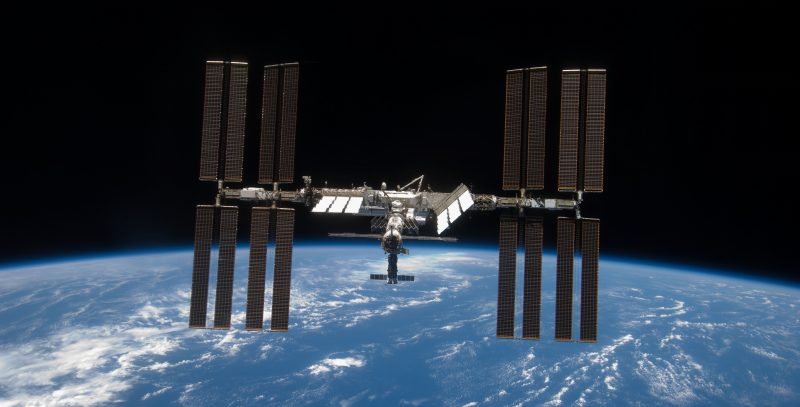 If you’ve been following ham radio news lately, no doubt you’ve heard that the International Space Station now has an FM repeater in operation. Pretty much any amateur radio operator can use this repeater with a capable dual band radio and (ideally) a directional antenna.
If you’ve been following ham radio news lately, no doubt you’ve heard that the International Space Station now has an FM repeater in operation. Pretty much any amateur radio operator can use this repeater with a capable dual band radio and (ideally) a directional antenna.
Here’s the information about the new system from an ARISS news release:
First Element of ARISS Next Generation (Next-Gen)
Radio System Installed in ISS Columbus ModuleSeptember 2, 2020—The ARISS team is pleased to announce that set up and installation of the first element of our next generation radio system was completed and amateur radio operations with it are now underway. This first element, dubbed the InterOperable Radio System (IORS), was installed in the International Space Station Columbus module. The IORS replaces the Ericsson radio system and packet module that were originally certified for spaceflight on July 26, 2000.
Initial operation of the new radio system is in FM cross band repeater mode using an uplink frequency of 145.99 MHz with an access tone of 67 Hz and a downlink frequency of 437.800 MHz. System activation was first observed at 01:02 UTC on September 2. Special operations will continue to be announced.
The IORS was launched from Kennedy Space Center on March 6, 2020 on board the SpaceX CRS-20 resupply mission. It consists of a special, space-modified JVC Kenwood D710GA transceiver, an ARISS developed multi-voltage power supply and interconnecting cables. The design, development, fabrication, testing, and launch of the first IORS was an incredible five-year engineering achievement accomplished by the ARISS hardware volunteer team. It will enable new, exciting capabilities for ham radio operators, students, and the general public. Capabilities include a higher power radio, voice repeater, digital packet radio (APRS) capabilities and a Kenwood VC-H1 slow scan television (SSTV) system.
A second IORS undergoes flight certification and will be launched later for installation in the Russian Service module. This second system enables dual, simultaneous operations, (e.g. voice repeater and APRS packet), providing diverse opportunities for radio amateurs. It also provides on-orbit redundancy to ensure continuous operations in the event of an IORS component failure.
Next-gen development efforts continue. For the IORS, parts are being procured and a total of ten systems are being fabricated to support flight, additional flight spares, ground testing and astronaut training. Follow-on next generation radio system elements include an L-band repeater uplink capability, currently in development, and a flight Raspberry-Pi, dubbed “ARISS-Pi,” that is just beginning the design phase. The ARISS-Pi promises operations autonomy and enhanced SSTV operations.
ARISS is run almost entirely by volunteers, and with the help of generous contributions from ARISS sponsors and individuals. Donations to the ARISS program for next generation hardware developments, operations, education, and administration are welcome — please go to https://www.ariss.org/donate.html to contribute to these efforts.
ARISS–Celebrating 20 years of continuous amateur radio operations on the ISS!
If you’d like to get a taste for what it’s like making contacts via the ISS repeater, check out this video from K0LWC (thanks for the tip, Paul):
Of course, you don’t have to be an amateur radio operator to listen to the traffic on the ISS repeater. All you need is a scanner or receiver that can tune to the downlink frequency of 437.800 MHz and coordinate your listening session with an ISS pass (I like using NASA’s Spot the Station service). You’ll stand a much better chance of working or listening to the ISS repeater with a high pass.
Have you made a successful contact via the ISS repeater already or listened to the repeater traffic? Please comment!

It doesn’t take a lot to listen the the new ISS repeater. I use my FT-897 and a 2m/70cm ground plane on my roof. There seems to be a lot of activity on every pass. Typical ham exchange is call sign and grid square.
With the new repeater will it be able to do APRS ……
Here’s a fun fact: There is an APRS repeater on the ISS. You can use the ISS as a relay to the APRS network. And APRS has a cellular gateway, which means you can send SMS messages to mobile phones via the ISS:
https://www.kj7nzl.net/blog/sending-sms-messages-through-iss/
The repeater is off right now. But there plans to add a second radio in the Russian segment later so they have two IORS modules running at the same time. Then they can operate both the repeater and digipeater.